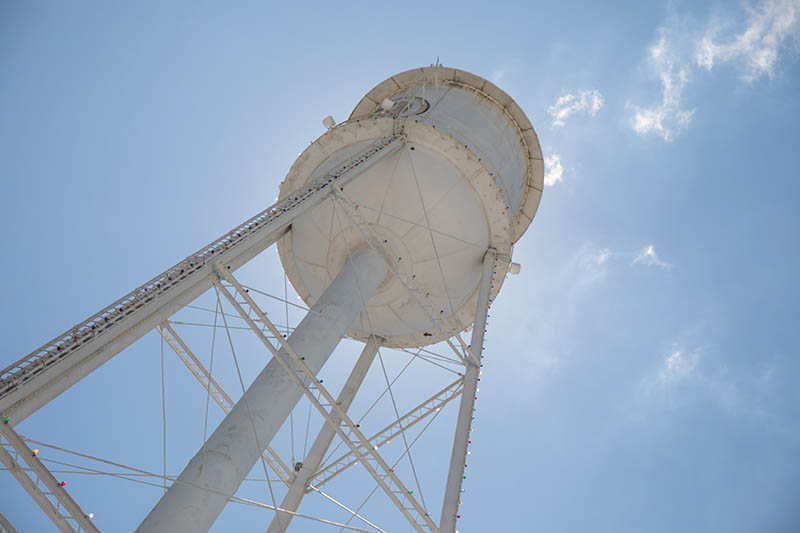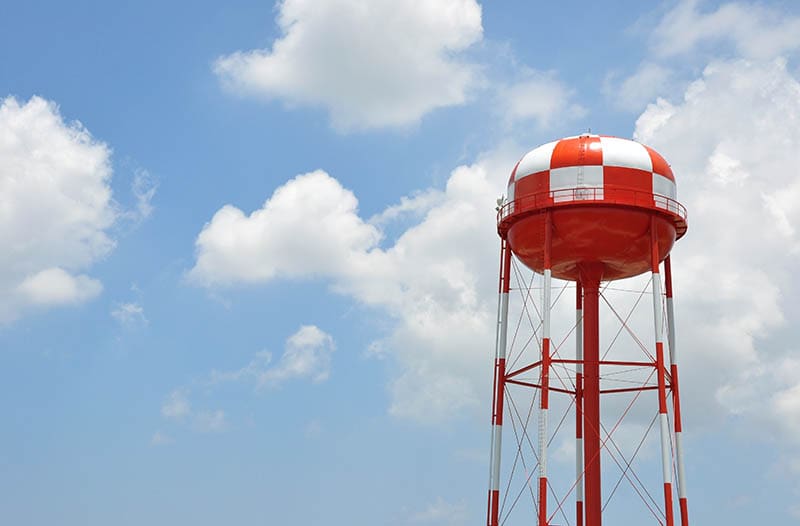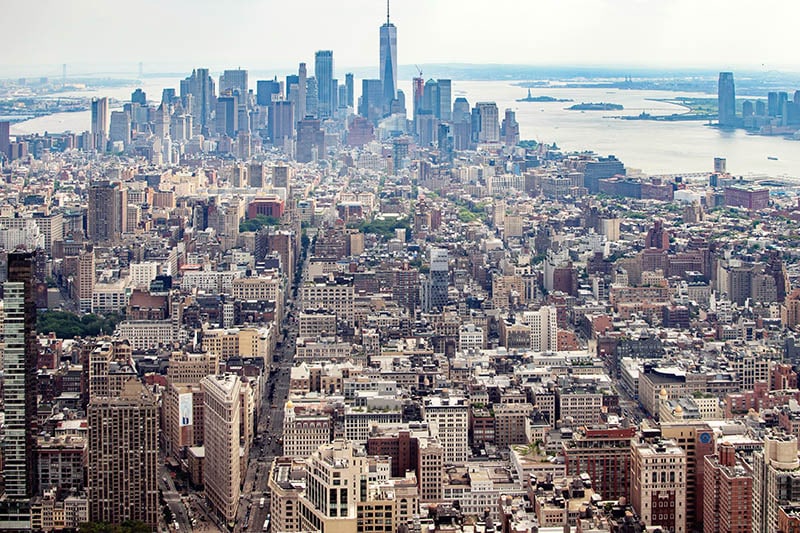How Do Water Towers Work? What to Know
-

- Last updated:

Outside of the taps in our homes, the local water tower is often the only side we see of the expansive and vital water network that makes communities function. And yet, familiar as they are, a surprising majority of people still don’t understand how water towers operate.
Water towers may seem like little more than simple storage tanks. But since the 1800s, these structures have played a critical role in supporting primary water reservoirs for cities across the country, ensuring residents have a dependable water supply at all times. They’re cost-effective and reliable. And when you know how water towers work, they’re also a lot less mysterious!
How Does It Work?
Water towers, also called elevated storage tanks, are tall structures supporting enclosed tanks that can hold anywhere from 150,000 to 4 million gallons of water. Treatment plants filter and decontaminate water, sending clear, potable water to a high-lift pump station. The station moves the water up a pipe into the bulbous tank at the top of the water tower. Another line leads down the structure, connecting to the area’s water network. In some designs, one pipe pulls double duty by filling the tank and distributing it to the city.
Not all of a city’s water moves through a water tower. Instead, the tank acts as a reserve system to meet peak water demand at certain times of the day. The pump station that fills the water tower also distributes water to feeder pipes directly connected to the various buildings and water outlets.
If the pump station can’t keep up with the area’s water usage, the system pulls water from the tower to make up the difference. At night, when people are sleeping and the demand is low, the pump’s output directs solely to the water tower, refilling it in preparation for the next day.

Why Water Towers Are Tall
Water towers work off simple physics to provide constant water to residents. Being so tall, they store water and energy via hydrostatic pressure.
Every building and water tap in the area sits at a lower elevation than the water tower’s tank. Since gravity is constantly pulling on the water in the tower, it’s under enough pressure for water to erupt at an acceptable flow rate when you turn on the faucet. There’s no electricity needed; it works simply off the tower’s natural inclination to drain itself.
Because they take advantage of elevation, most water towers sit on high ground. Designers can build shorter structures and save on costs when they sit at a higher level. Some areas can even use ground-level tanks situated on high hills.
Water Tower Placement
Water pressure changes according to a building’s elevation relative to the water tower serving it. Each additional foot of a water tower’s height increases the water pressure by 0.43 psi.
Imagine one water tower serving two homes: one on a hill and one in a valley. The home in the valley would have more powerful water pressure than the home on the hill because the tower is much higher above it.
The difference in water pressure between homes in areas with varying elevations can be problematic for a single tower. The average water tower supplies 50–100 psi. If a home is so far below the tower that the pressure exceeds the standard threshold, it can damage plumbing, appliances, and water heaters. The chance of leaks will increase, as will your utility bills.
On the flip side, low water pressure can cause usage issues in the home and allow contaminants to enter the supply lines through leaks. If water pressure drops too low, the city may issue a boil order to residents.
Homes can include pressure-regulating valves and pumps to manage water pressure, adding installation and maintenance demands for homeowners. As an alternative, many municipalities strategically place several towers to ensure optimal water pressure for all residents. One tower may be at a higher elevation to supply buildings on a hill, while another may sit at a lower elevation to provide backup water to homes and buildings in a valley. Designers generally size the tanks to hold a day’s water supply for the service area.
What Are the Different Types of Water Towers?
Water towers vary in height, tank size, and location according to the needs of the systems and sites connecting to them. The most common building materials are steel and concrete. Composite towers utilize concrete foundations and steel storage tanks in cost-effective, low-maintenance designs. Meanwhile, many towers from the early 1900s consist of brick and masonry, often giving them a Romanesque or Gothic aesthetic.
Tower shapes can differ as well. Often the most cost-effective solution, a multi-legged tower typically has exposed piping, an exterior ladder, and a catwalk circling the storage tank. Many newer constructions use a pedestal instead. In these designs, all the pipes, ladders, and lift systems live inside an enclosed cylinder supporting the tank. Pedestals prevent unwanted trespassers from climbing the structure while providing extra storage and improved aesthetics over multi-legged styles.

Where Are Water Towers Used?
Water towers are common in populated regions across the globe. They are one of the first features you’ll notice as you drive into a new town, and you may see several dotted across the landscape. Flatter areas often use a single, high-capacity water tower, while those with varied elevations may utilize several smaller structures.
In many communities, the local water tower’s importance transcends its function and becomes a historic landmark or essential tourist attraction. The following are some of the more unique water towers across the United States:
- The Peachoid: A peach-shaped water tower in Gaffney, SC
- The Alhambra Water Tower: A Spanish-style structure resembling a lighthouse in Coral Gables, FL
- The Ear of Corn Water Tower: A tower in Rochester, MN, that looks like, you guessed it, an ear of corn
- The 8-Ball Water Tower: A structure representing a billiard ball in Tipton, MO
Decommissioned water towers remain critical cultural symbols for many towns. Residents of Louisville, KY, refused to get rid of the Dixie Cup tower, for example, and it now serves as a beacon for air traffic. Others, such as the Sunset Beach Water Tower, have even undergone remodels to become livable structures.
NYC Water Towers
One of the defining features of New York City is the water towers gracing the tops of nearly every building in sight. As part of the city’s regulations, every building over six stories must include a water tower to supply adequate pressure to every floor. And if you’ve been to NYC, you know there are plenty of buildings over six stories tall.
About 15,000 water towers exist across the urban landscape, each with roughly 10,000 gallons of capacity that fills in only 2–3 hours. A pump at the bottom of the building fills the tank, which slowly empties throughout the day to keep up with water demands.
Unlike the larger steel towers supporting entire communities, NYC water towers are wooden. The wood is untreated and unpainted to prevent water contamination. Out in the elements, the lack of protection causes the exterior to weather quickly. That’s why even the newest water towers look several decades old.
Wood is a preferred material over steel for several reasons. Though it’s lighter in weight and easier to install, wood provides superior insulation. It only takes a few inches of wood to ensure water doesn’t become too hot or cold as temperatures fluctuate. Wooden towers also last roughly 30–50 years. While that isn’t as long-lasting as steel, they often run at about one-third of the price of metal tanks, making them far more cost-efficient.

 Advantages of Water Towers
Advantages of Water Towers
The primary benefit of water towers is that they allow water utilities to size pumps according to average daily use rather than peak use. Water usage fluctuates throughout the day. In the morning, people turn their sprinklers on, take showers, run coffee pots, and brush their teeth, putting a heavy demand on the system. Usage slows during the day and picks up again in the early evening as people give kids baths and make dinner. At night, water demand drops to almost nothing as everyone sleeps.
With a water tower, you only have to use a pump with enough capacity to handle average usage. At night, the pump’s power goes toward filling the water tank. The pump can’t manage the whole water demand in the morning, but the tank can kick in to help. When usage drops below pump capacity, the pump begins filling the tank again. Operating this way is efficient for several reasons.

Water Towers Can Cut Costs
Without a tower, a community would rely on a pump alone, and it would have to be large enough to handle peak demand rather than average demand. Usage during peak hours can be up to five times greater than the daily average, meaning the pump would need to be five times larger, or the town would have to use five times as many pumps. Water towers let towns scale back infrastructure requirements at the pump station and at several stages leading back to the water treatment facility.
Alongside equipment savings, communities also cut energy costs by using a tower. They reduce wear and unnecessary energy usage by not having to turn pumps on and off as demand changes throughout the day. And since electricity in many areas is cheaper during non-peak hours, they can significantly reduce power bills by running pumps at night to fill the tower. During the day, when electricity is more expensive., they can run off the stored water and limit pump usage.
Emergency Water
Since the only power involved in a water tower comes from pressure, it can continue operating when there is a failure in the supply system. Service areas can continue receiving water if a power outage knocks out the pumps or water is low at the treatment facility.
The emergency system also ensures firefighters always have adequate water pressure at hydrants. Cities can more easily meet the minimum requirements for their firefighting units by using water towers. In some instances, they can even lower insurance rates for residents and business owners.
Disadvantages of Water Towers
Water towers don’t come without their share of costs, and some areas use pumps rather than towers to avoid the drawbacks. At the outset, the land and financial investment to construct a water tower can be prohibitive for many places. Depending on the location and size of the population, water towers can cost up to $8 million to build.

Maintenance and Cleanliness
After construction, maintenance becomes a critical cost consideration. Water towers need frequent repairs for equipment and leaks. More importantly, they need regular cleaning every 3–5 years to remove sediment and other contaminants. Without routine maintenance, individuals connected to water towers have had exposure to coliform, E. coli, legionella, and a host of other dangerous pathogens.
Failed regulation and compliance are unfortunately common across the country. Because of poor management, snakes, dead birds, and other creatures have appeared in tanks. Many water tower operators don’t perform the required inspections and upkeep to keep the water safe. Some towers that are several decades old have gone their entire lives without any cleaning.
In New York City, where maintenance must occur once a year, countless water towers are heavily contaminated with debris and disease. After years of neglect, many even feature gaping holes in their roofs, inviting everything from cockroaches to large rodents and birds.
At state and city levels, regulators and health departments fail to provide proper oversight. Rules enforcement is lax, and only a handful of states require interior inspections. It’s challenging to say how many people get sick annually from dirty water towers, but with contaminated tap water contributing to millions of illnesses and hundreds of deaths every year, there’s a decent chance they play a role.
Frequently Asked Questions

How Tall Is an Average Water Tower?
Towers vary in height depending on their elevation relative to the homes and buildings receiving water. Given the 0.43 psi difference per foot and the 50–100 psi requirement for adequate flow, a tank would be at least 120 feet above the taps it serves. On a high hill, a water tank could sit at ground level. Conversely, it may have to be over 150 feet tall if it’s on a plain with tall buildings nearby. The tallest towers in America are the 218-foot tower in Edmond, OK, and the 216-foot spheroid in Union, NJ.
Can Water in a Tower Freeze?
The natural inward and outward circulation throughout the day, alongside its immense volume, keeps most of the water in a water tower from turning to ice. Northern climates carry a higher risk of freezing, so many engineers take extra precautions to prevent extreme temperature drops. Pipes feeding the tank may have added insulation and heat tape. A separate heating system using hot water or steam can also come into play to slow freezing.
Conclusion
Water towers are a prime example of the beauty of simplicity. For centuries, communities have sustained themselves on this simple manipulation of gravity, ensuring a steady and reliable resource for growing populations. While the concept hasn’t needed much change over the years, these structures have evolved into iconic features across the country. And now that you know how water towers work, you can have even more appreciation for their importance to the communities they serve.
Featured Image Credit: Becky Wright Photography, Shutterstock
Contents

 Advantages of Water Towers
Advantages of Water Towers